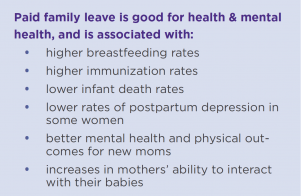April 6, 2016

Paid Family Leave Supports Healthy Brain Development and Promotes Healthy Families

Smart policies that support the bond between parents and their newborn will help our state realize every child’s full potential to contribute to our shared economic and social vitality. As Connecticut considers current legislation to provide working families with paid family leave, many economic, social and health factors come into play. This issue brief draws on CHDI’s policy brief, Ensuring the Best Start for Connecticut’s Children: Aligning Policy with Science (March 2016) which examined paid family leave policy opportunities from a child health perspective.
One of the most compelling reasons for paid family leave is the research showing that secure infant attachment supports healthy brain development and leads to better life-long outcomes for children. Early experiences are fundamental to shaping brain developmen t, specifically through the relationship that a child has with his or her parent or caregiver. An infant’s secure attachment to his or her parent or caregiver is the primary source of a child’s security, self-esteem, self-control and development of social skills. This foundation has implications for every phase of development that follows. As in any construction project, foundations matter.
t, specifically through the relationship that a child has with his or her parent or caregiver. An infant’s secure attachment to his or her parent or caregiver is the primary source of a child’s security, self-esteem, self-control and development of social skills. This foundation has implications for every phase of development that follows. As in any construction project, foundations matter.
Neuroscience also suggests that young children’s brains are negatively impacted by adverse or traumatic events. Chronic exposure to these traumatic events can cause a response that is toxic and stresses the rapidly developing structure of the brain in the first three years of life. Without the powerful buffering effect of a nurturing caregiver, this early exposure to traumatic experiences can have life-long consequences for the child’s physical and emotional well-being.
Since children’s healthy development depends on consistent, supportive interactions with their caregivers, parents need time to establish this crucial bond with their children and paid parental leave provides that critical resource.
The United States is one of just three countries (of 185) that do not guarantee paid maternity leave. Currently the federal Family and Medical Leave Act (FMLA) offers 12-16 weeks of unpaid, job-protected leave to recover from an illness or to care for a new baby or a sick family member. While 60 percent of the U.S. workforce is eligible for this benefit, millions of Americans cannot afford to take the FMLA unpaid leave, resulting in critical infant-parent bonding time being cut short.
Realizing that national paid family leave would benefit workers and their children, particularly, low wage earners, the federal Family and Medical Insurance Leave (FAMILY) Act was introduced in Congress in March 2015. The proposed legislation would give workers in all companies, including part-time employees, up to 12 weeks of partial income. It would be funded by employee and employer payroll contributions averaging about $1.50 per week.
In the meantime, four states have forged ahead and enacted their own government-run paid family leave programs: California, New Jersey, Rhode Island and most recently, New York. Washington State also passed a paid family leave law, but it was not funded. Additionally, Connecticut, Washington D.C. and New Hampshire are currently exploring paid family leave options.
In Connecticut, policymakers are getting closer to enacting paid family leave. In 2015, the Connecticut State Legislature passed a budget implementer bill, which allocated funds to conduct an actuarial analysis and feasibility plan for a system of paid family medical leave. The Institute of Women’s Policy and Research conducted the analysis; which included a review of the technology, infrastructure, and staffing needed to create a paid leave program in Connecticut. The report released in early 2016 presented five different paid family leave models, which are all sustainable in that the costs associated with benefits and administration do not exceed the program’s income.
Following this actuarial analysis, legislation was re-introduced in February (Raised S.B. 221: “An Act Concerning Paid Family and Medical Leave”) by the Labor and Public Employees Committee. The bill proposes up to 12 weeks of paid family leave (not to exceed $1,000 per week) to covered employees who contribute to a Family and Medical Leave Compensation Trust Fund, which will be established by this legislation. The bill has 14 co-sponsors and has been placed on the Senate Calendar for a vote.
Paid family leave is one of eight policy opportunities identified in CHDI’s policy brief Ensuring the Best Start for Connecticut’s Children: Aligning Policy with Science. These policy opportunities emerged from a summit of early childhood experts and leaders and by an exploration of examples from other states. Investing in the early years of a child’s life with policies that support the bond between parents and their newborns and mitigate circumstances that interrupt this attachment has positive outcomes that carry forward to adulthood and benefit everyone in our state.
For more information contact Abby Alter at alter@uchc.edu or (860)-679-8788. Visit www.chdi.org to download “Ensuring the Best Start for Connecticut’s Children: Aligning Policy with Science" or to learn more about our work. Information for parents and caregivers is available at www.kidsmentalhealthinfo.com.